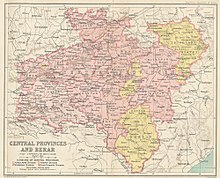Nagpur Province: Difference between revisions
ce tag |
mNo edit summary |
||
| Line 35: | Line 35: | ||
==History== |
==History== |
||
Nagpur Province was formed in 1853 when the British annexed the [[princely state]] of [[Nagpur state|Nagpur]] by virtue of the [[Doctrine of lapse]]. |
Nagpur Province was formed in 1853 when the British annexed the [[princely state]] of [[Nagpur state|Nagpur]], by virtue of the [[Doctrine of lapse]]. |
||
The Province included the domains of the [[Maratha]] [[Bhonsle]] Maharajas of Nagpur, powerful members of the [[Maratha Confederacy]] who conquered large tracts of central and eastern India in the 18th century.<ref>Malleson, G. B.: ''An historical sketch of the native states of India,'' London 1875, Reprint Delhi 1984</ref> In 1818, at the conclusion of the [[Third Anglo-Maratha War]], the Bhonsle Maharaja submitted to a [[subsidiary alliance]], and Nagpur became a [[princely state]] under the [[suzerainty]] of the British crown. In 1853, on the death of Maharaja Raghoji III without heirs, Nagpur was annexed by the British under the [[doctrine of lapse]]. It was thereafter administered by a commissioner under the [[Governor-General of India]]. |
The Province included the domains of the [[Maratha]] [[Bhonsle]] Maharajas of Nagpur, powerful members of the [[Maratha Confederacy]] who conquered large tracts of central and eastern India in the 18th century.<ref>Malleson, G. B.: ''An historical sketch of the native states of India,'' London 1875, Reprint Delhi 1984</ref> In 1818, at the conclusion of the [[Third Anglo-Maratha War]], the Bhonsle Maharaja submitted to a [[subsidiary alliance]], and Nagpur became a [[princely state]] under the [[suzerainty]] of the British crown. In 1853, on the death of Maharaja Raghoji III without heirs, Nagpur was annexed by the British under the [[doctrine of lapse]]. It was thereafter administered by a commissioner under the [[Governor-General of India]]. |
||
Revision as of 02:05, 24 June 2017
This article may require copy editing for grammar, style, cohesion, tone, or spelling. (April 2017) |
| Nagpur Province नागपूर | |||||||||
|---|---|---|---|---|---|---|---|---|---|
| Province of British India | |||||||||
| 11 December 1853–1861 | |||||||||
|
Flag | |||||||||
 Map of the Central provinces of British India | |||||||||
| History | |||||||||
• British annexation of Nagpur State | 11 December 1853 | ||||||||
• Merger with the Saugor and Nerbudda Territories | 1861 | ||||||||
| |||||||||
Nagpur Province was a province of British India that covered parts of present-day Madhya Pradesh, Maharashtra, and Chhattisgarh states. The city of Nagpur was the capital of the province.
In 1861 it was merged into the Central Provinces together with the Saugor and Nerbudda Territories.[1]
History
Nagpur Province was formed in 1853 when the British annexed the princely state of Nagpur, by virtue of the Doctrine of lapse. The Province included the domains of the Maratha Bhonsle Maharajas of Nagpur, powerful members of the Maratha Confederacy who conquered large tracts of central and eastern India in the 18th century.[2] In 1818, at the conclusion of the Third Anglo-Maratha War, the Bhonsle Maharaja submitted to a subsidiary alliance, and Nagpur became a princely state under the suzerainty of the British crown. In 1853, on the death of Maharaja Raghoji III without heirs, Nagpur was annexed by the British under the doctrine of lapse. It was thereafter administered by a commissioner under the Governor-General of India.
In 1861, Nagpur Province was merged with the Saugor and Nerbudda Territories to constitute the new Central Provinces and Berar administrative division. The districts of Nagpur, Bhandara, Chada, Wardha, and Balaghat became the Nagpur Division of the new province, while Durg, Raipur, and Bilaspur became the Chhattisgarh Division. Chhindwara District was added to Nerbudda Division.[3]
Districts
Provincial Commissioners
- ----- Mansel (took office on 13 March 1854, before resident at Nagpur), 1854
- Captain Elliot, 1854 - 1855
- G. Plowden, 1855 - 1860
- (vacant) 1860 - 1861
References
- ^ Hunter, William Wilson, Sir, et al. (1908). Imperial Gazetteer of India, 1908-1931; Clarendon Press, Oxford
- ^ Malleson, G. B.: An historical sketch of the native states of India, London 1875, Reprint Delhi 1984
- ^ History; Gazetteer, 1966

